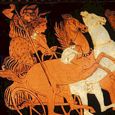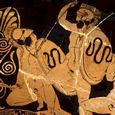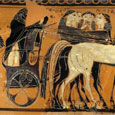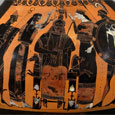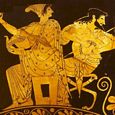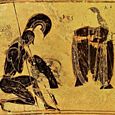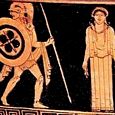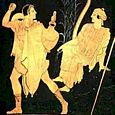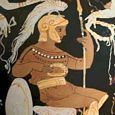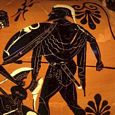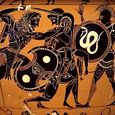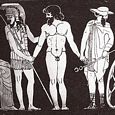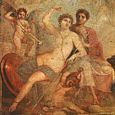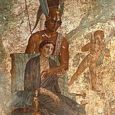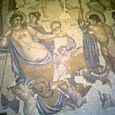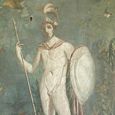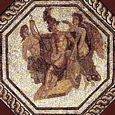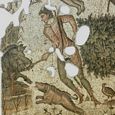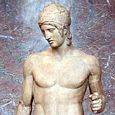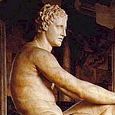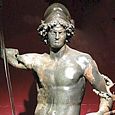ARES
Greek Name
Αρης
Transliteration
Arês
Latin Spelling
Ares
Translation
Mars
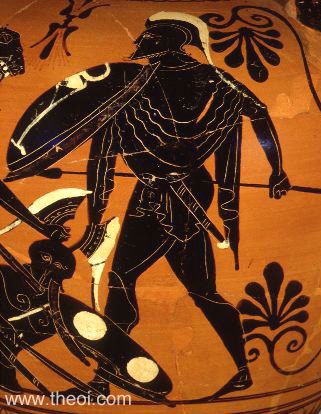
ARES was the Olympian god of war, battlelust, courage and civil order. In ancient Greek art he was depicted as either a mature, bearded warrior armed for battle, or a nude, beardless youth with a helm and spear.
MYTHS
Ares had an adulterous affair with the goddess Aphrodite but her husband Hephaistos trapped the pair in a golden net and humiliated them by calling the rest of the gods to witness. <<More>>
When Aphrodite fell in love with the handsome youth Adonis, the god grew jealous, transformed himself into a boar, and gorged the boy to death as he was out hunting. <<More>>
Ares transformed his daughter Harmonia and her husband Kadmos (Cadmus) of Thebes into serpents and had them carried away to the Islands of the Blessed. <<More>>
The god slew Hallirhothios to avenge the rape of his daughter Alkippe. He was tried at the court of the Areiopagos in Athens but acquitted of murder. <<More>>
Ares apprehended the criminal Sisyphos, an impious man who had dared to kidnap the god of death Thanatos. <<More>>
During the battle between Herakles and Ares' villianous Kyknos (Cycnus), the god intervened but was wounded by the hero and forced to flee back to Olympos. <<More>>
Ares actively supported his Amazon-queen daughters in their many wars and battles. The most celebrated of these was Penthesileia who joined the Trojan War. <<More>>
When the Aloadai giants laid siege to Olympos, Ares battled them but was defeated and imprisoned in a bronze jar. He was later rescued by the god Hermes. <<More>>
During the course of the Trojan War, Ares, who had sided with the Trojans, was wounded by the Greek hero Diomedes who drove a spear into his side, sending him flying back to Olympos bellowing in pain. <<More>>
Many other minor myths are detailed over the following pages.
SYMBOLS & ATTRIBUTES
Ares' main attribute was a peaked warrior's helm. Even in domestic scenes, such as feasts of the gods, he was
depicted either wearing or holding his helm. The god's other attributes included a shield, a spear and sometimes
a sheathed sword. Although his shield was often decorated with an emblem of some sort, ancient artists simply
used a generic one drawn from their standard repertoire rather than something specific to the god.
Ares was usually dressed as a standard Greek warrior with a short tunic, breastplate, helm and greaves. The
breastplate was often ommitted in favour of a simple tunic, and he was sometimes depicted nude except for the
helm and shield. Ares can be quite difficult to identify in ancient Greek art as there is little to distinguish
him from other warrior figures. <<More>>
SACRED ANIMALS
Ares' sacred animal was the serpent. He was also associated with certain birds, such as the vulture and a few species of owl, which ancient augury identified as portents of war, sedition and ill-fortune. <<More>>
The most famous of the god's animals in myth were the Colchian Dragon, a serpent set by Ares to guard the Golden Fleece, and the Ismenian Dragon, a giant snake which guarded his sacred spring near Thebes. <<More>>
ARES PAGES ON THEOI.COM
This site contains a total of 13 pages describing the god, including general descriptions, mythology, and cult. The content is outlined in the Index of Ares Pages list (left column or below).
FAMILY OF ARES
PARENTS
[1.1] ZEUS & HERA (Hesiod
Theogony 921, Homer Iliad 5.699, Aeschylus Frag 282, Apollodorus 1.13, Pausanias 2.14.3, Hyginus Preface, et
al)
[1.2] HERA (no father) (Ovid Fasti 5.229)
OFFSPRING
See Family of Ares
Ares was a son of Zeus and Hera, King and Queen of the Gods, and brother of the goddesses Eileithyia and Hebe.
His half-brothers and sisters included Athena, Aphrodite, Apollon, Artemis, Hermes, Dionysos and Hephaistos.
Ares had three children by the goddess Aphrodite named Deimos (Fear), Phobos (Terror), and Harmonia (Harmony).
His daughter Harmonia's daughter Semele was the mother of the god Dionysos.
Ares also had numerous mortal offspring. Many of these inherited their father's violent temperament and in myth
were often cast in the role of villains. <<More>>
Below are two graphics depicting Ares' family tree, the first with names transliterated from the Greek and the second with the common English spellings:-
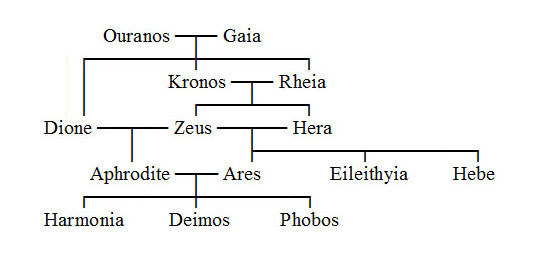
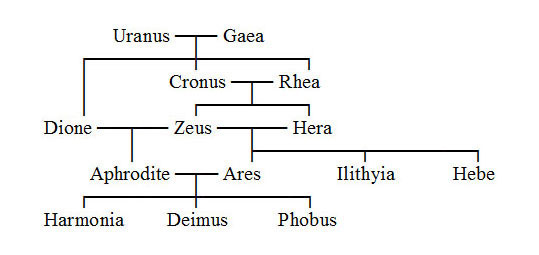
ENCYCLOPEDIA
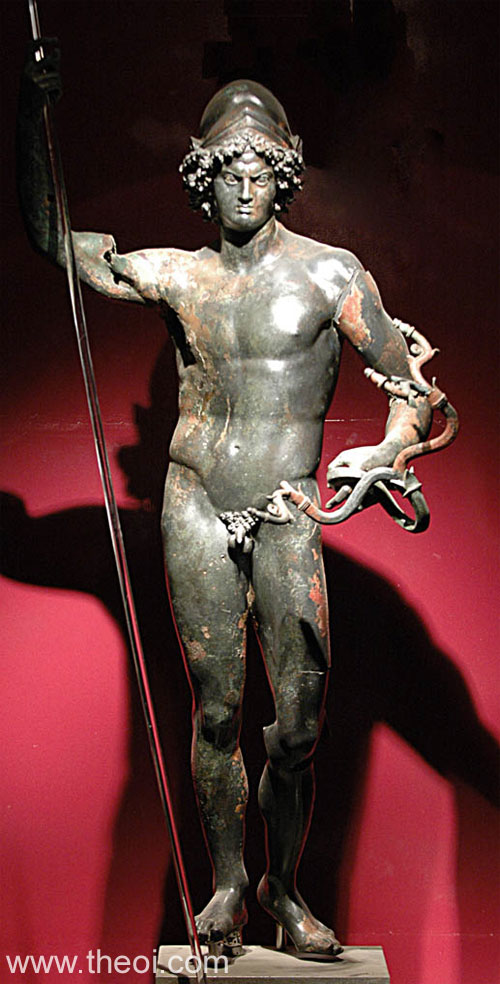
ARES (Arês), the god of war and one of the great Olympian gods of the Greeks. He is represented as the son of Zeus and Hera. (Hom. Il. v. 893, &c.; Hes. Theog. 921; Apollod. i. 3. § 1.) A later tradition, according to which Hera conceived Ares by touching a certain flower, appears to be an imitation of the legend about the birth of Hephaestus, and is related by Ovid. (Fast. v. 255, &c.)
The character of Ares in Greek mythology will be best understood if we compare it with that of other divinities who are likewise in some way connected with war. Athena represents thoughtfulness and wisdom in the affairs of war, and protects men and their habitations during its ravages. Ares, on the other hand, is nothing but the personification of bold force and strength, and not so much the god of war as of its tumult, confusion, and horrors. His sister Eris calls forth war, Zeus directs its course, but Ares loves war for its own sake, and delights in the din and roar of battles, in the slaughter of men, and the destruction of towns. He is not even influenced by party-spirit, but sometimes assists the one and sometimes the other side, just as his inclination may dictate; whence Zeus calls him alloposallos. (Il. v. 889.) The destructive hand of this god was even believed to be active in the ravages made by plagues and epidemics. (Soph. Oed. Tyr. 185.) This savage and sanguinary character of Ares makes him hated by the other gods and his own parents. (Il. v. 889-909.) In the Iliad, he appears surrounded by the personifications of all the fearful phenomena and effects of war (iv. 440, &c., xv. 119, &c.); but in the Odyssey his character is somewhat softened down.
It was contrary to the spirit which animated the Greeks to represent a being like Ares, with all his overwhelming physical strength, as always victorious; and when he comes in contact with higher powers, he is usually conquered. He was wounded by Diomedes, who was assisted by Athena, and in his fall he roared like nine or ten thousand other warriors together. (Il. v. 855, &c.) When the gods began to take an active part in the war of the mortals, Athena opposed Ares, and threw him on the ground by hurling at him a mighty stone (xx. 69, xxi. 403, &c.); and when he lay stretched on the earth, his huge body covered the space of seven plethra.
The gigantic Aloadae had likewise conquered and chained him, and had kept him a prisoner for thirteen months, until he was delivered by Hermes. (v. 385, &c.) In the contest of Typhon against Zeus, Ares was obliged, together with the other gods, to flee to Egypt, where he metamorphosed himself into a fish. (Antonin. Lib. 28.) He was also conquered by Heracles, with whom he fought on account of his son Cycnus, and obliged to return to Olympus. (Hesiod, Scut. Herc. 461.) In numerous other contests, however, he was victorious.
This fierce and gigantic, but withal handsome god loved and was beloved by Aphrodite : he interfered on her behalf with Zeus (v. 883), and lent her his war-chariot. (v. 363; comp. Aphrodite.) When Aphrodite loved Adonis, Ares in his jealonsy metamorphosed himself into a bear, and killed his rival.
According to a late tradition, Ares slew Halirrhotius, the son of Poseidon, when he was on the point of violating Alcippe, the daughter of Ares. Hereupon Poseidon accused Ares in the Areiopagus, where the Olympian gods were assembled in court. Ares was acquitted, and this event was believed to have given rise to the name Areiopagus. (Dict. of Ant. s. v.)
The warlike character of the tribes of Thrace led to the belief, that the god's residence was in that country, and here and in Scythia were the principal seats of his worship. (Hom. Od. viii. 361, with the note of Eustath.; Ov. Ars Am. ii. 585 ; Statius, Theb. vii. 42; Herod. iv. 59, 62.) In Scythia he was worshipped in the form of a sword, to which not only horses and other cattle, but men also were sacrificed. Respecting the worship of an Egyptian divinity called Ares, see Herodotus, ii. 64.
He was further worshipped in Colchis, where the golden fleece was suspended on an oak-tree in a grove sacred to him. (Apollod. i. 9. § 16.) From thence the Dioscuri were believed to have brought to Laconia the ancient statue of Ares which was preserved in the temple of Ares Thareitas, on the road from Sparta to Therapnae. (Paus. iii. 19. § 7, &c.) The island near the coast of Colchis, in which the Stymphalian birds were believed to have dwelt, and which is called the island of Ares, Aretias, Aria, or Chalceritis, was likewise sacred to him. (Steph. Byz. s. v. Areos nêsos; Apollon. Rhod. ii. 1047; Plin. H. N. vi. 12; Pomp. Mela, ii. 7. § 15.)
In Greece itself the worship of Ares was not very general. At Athens he had a temple containing a statue made by Alcamenes (Paus. i. 8. § 5); at Geronthrae in Laconia he had a temple with a grove, where an annual festival was celebrated, during which no woman was allowed to approach the temple. (iii. 22. § 5.) He was also worshipped near Tegea, and in the town (viii. 44. § 6, 48. § 3), at Olympia (v. 15. § 4), near Thebes (Apollod. iii. 4. § 1), and at Sparta, where there was an ancient statue, representing the god in chains, to indicate that the martial spirit and victory were never to leave the city of Sparta. (Paus. iii. 15. § 5.) At Sparta human sacrifices were offered to Ares. (Apollod. Fragm. p. 1056, ed. Heyne.) The temples of this god were usually built outside the towns, probably to suggest the idea that he was to prevent enemies from approaching them.
All the stories about Ares and his worship in the countries north of Greece seem to indicate that his worship was introduced in the latter country from Thrace; and the whole character of the god, as described by the most ancient poets of Greece, seems to have been thought little suited to be represented in works of art : in fact, we hear of no artistic representation of Ares previous to the time of Alcamenes, who appears to have created the ideal of Ares. There are few Greek monuments now extant with representations of the god; he appears principally on coins, reliefs, and gems. The Romans identified their god Mars with the Greek Ares.
Source: Dictionary of Greek and Roman Biography and Mythology.
CLASSICAL LITERATURE QUOTES
HYMNS TO ARES
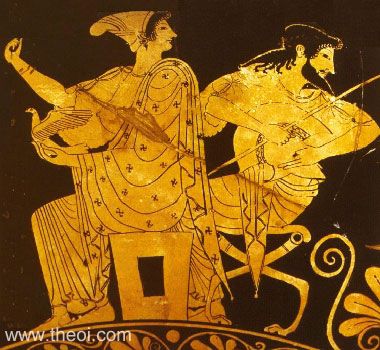
I) THE HOMERIC HYMNS
Homeric Hymn 8 to Ares (trans. Evelyn-White) (Greek epic B.C.) :
"Ares, exceeding in strength, chariot-rider, golden-helmed, doughty in heart, shield-bearer, Saviour of
cities, harnessed in bronze, strong of arm, unwearying, mighty with the spear, O defender of Olympos, father of
warlike Nike (Victory), ally of Themis, stern governor of the rebellious, leader of the righteous men, sceptred
King of manliness, who whirl your fiery sphere [the star Mars] among the planets in their sevenfold courses
through the aither wherein your blazing steeds ever bear you above the third firmament of heaven; hear me,
helper of men, giver of dauntless youth! Shed down a kindly ray from above upon my life, and strength of war,
that I may be able to drive away bitter cowardice from my head and crush down the deceitful impulses of my soul.
Restrain also the keen fury of my heart which provokes me to tread the ways of blood-curdling strife. Rather, O
blessed one, give you me boldness to abide within the harmless laws of peace, avoiding strife and hatred and the
violent fiends of death."
II) THE ORPHIC HYMNS
Orphic Hymn 65 to Ares (trans. Taylor) (Greek hymns C3rd B.C. to 2nd A.D.)
:
"To Ares, Fumigation from Frankincense. Magnanimous, unconquered, boisterous Ares, in darts rejoicing, and
in bloody wars; fierce and untamed, whose mighty power can make the strongest walls from their foundations
shake: mortal-destroying king, defiled with gore, pleased with war’s dreadful and tumultuous roar. Thee
human blood, and swords, and spears delight, and the dire ruin of mad savage fight. Stay furious contests, and
avenging strife, whose works with woe embitter human life; to lovely Kypris (Cypris) [Aphrodite] and to Lyaios
(Lyaeus) [Dionysos] yield, for arms exchange the labours of the field; encourage peace, to gentle works
inclined, and give abundance, with benignant mind."
PHYSICAL DESCRIPTIONS OF ARES
Classical literature offers only a few, brief descriptions of the physical characteristics of the gods.
Homer, Iliad 5. 592 ff (trans. Lattimore) (Greek epic C8th B.C.) :
"Ares made play in his hands with spear gigantic and ranged now in front of Hektor and now behind him.
Diomedes of the great war cry shivered [with fear] as he saw him."
Homer, Iliad 18. 516 ff :
"[In a battle-scene engraved on the shield of Akhilleus (Achilles):] And Ares led them [an army of men],
and Pallas Athene. These were gold, both, and golden raiment upon them, and they were beautiful and huge in
their armour, being divinities, and conspicuous from afar, but the people around them were smaller."
Hesiod, Shield of Heracles 56 ff (trans. Evelyn-White) (Greek epic C8th or 7th B.C.)
:
"Ares insatiable in battle, blazing like the light of burning fire in his armour and standing in his
chariots, and his running horses trampled and dented the ground with their hooves . . . And all the grove and
the altar . . . were lighted up by the dread god, Ares, himself and his armour, and the shining from his eyes
was like fire . . . manslaughtering Ares screaming aloud, courses all over the sacred grove."
Hesiod, Shield of Heracles 191 ff :
"[In a battle-scene engraved on the shield of Herakles:] And on the shield stood the fleet-footed horses of
grim Ares made gold, and deadly Ares the spoil-winner himself. He held a spear in his hands and was urging on
the footmen: he was red with blood as if he were slaying living men, and he stood in his chariot. Beside him
stood Deimos (Fear) and Phobos (Flight), eager to plunge amidst the fighting men."
Quintus Smyrnaeus, Fall of Troy 1. 923 ff (trans. Way) (Greek epic C4th A.D.)
:
"Straight from Olympus down he [Ares] darted, swift and bright as thunderbolt terribly flashing from the
mighty hand of Zeus."
Quintus Smyrnaeus, Fall of Troy 7. 400 ff :
"Ares, to gory strife he speedeth, wroth with foes, when maddeneth his heart, and grim his frown is, and
his eyes flash levin-flame around him, and his face is clothed with glory of beauty terror-blent, as on he
rusheth: quail the very gods."
ANCIENT GREEK & ROMAN ART
SOURCES (ALL ARES PAGES)
GREEK
- Homer, The Iliad - Greek Epic C8th B.C.
- Homer, The Odyssey - Greek Epic C8th B.C.
- Hesiod, Theogony - Greek Epic C8th - 7th B.C.
- Hesiod, The Shield of Heracles - Greek Epic C8th - 7th B.C.
- Hesiod, Catalogues of Women Fragments - Greek Epic C8th - 7th B.C.
- The Homeric Hymns - Greek Epic C8th - 4th B.C.
- Epic Cycle, The Aethiopis Fragments - Greek Epic C8th B.C.
- Epic Cycle, The Telegony Fragments - Greek Epic C8th - 6th B.C.
- Greek Lyric II Anacreontea, Fragments - Greek Lyric C5th - 4th B.C.
- Greek Lyric III Stesichorus, Fragments - Greek Lyric C7th - 6th B.C.
- Greek Lyric III Ibycus, Fragments - Greek Lyric C6th B.C.
- Greek Lyric III Simonides, Fragments - Greek Lyric C6th - 5th B.C.
- Greek Lyric IV Corinna, Fragments - Greek Lyric C5th B.C.
- Greek Elegaic Mimnermus, Fragments - Greek Elegaic C7th B.C.
- Greek Elegaic Theognis, Fragments - Greek Elegaic C6th B.C.
- Aeschylus, Agamemnon - Greek Tragedy C5th B.C.
- Aeschylus, Eumenides - Greek Tragedy C5th B.C.
- Aeschylus, Libation Bearers - Greek Tragedy C5th B.C.
- Aeschylus, Seven Against Thebes - Greek Tragedy C5th B.C.
- Aeschylus, Suppliant Women - Greek Tragedy C5th B.C.
- Aeschylus, Fragments - Greek Tragedy C5th B.C.
- Euripides, Bacchae - Greek Tragedy C5th B.C.
- Herodotus, Histories - Greek History C5th B.C.
- Plato, Cratylus - Greek Philosophy C4th B.C.
- Plato, Laws - Greek Philosophy C4th B.C.
- Plato, Republic - Greek Philosophy C4th B.C.
- Apollodorus, The Library - Greek Mythography C2nd A.D.
- Apollonius Rhodius, The Argonautica - Greek Epic C3rd B.C.
- Callimachus, Hymns - Greek Poetry C3rd B.C.
- Callimachus, Fragments - Greek Poetry C3rd B.C.
- Greek Papyri III Euphorion, Fragments - Greek Epic C3rd B.C.
- Greek Papyri III Amyntas, Fragments - Greek Elegiac C2nd B.C.
- Diodorus Siculus, The Library of History - Greek History C1st B.C.
- Strabo, Geography - Greek Geography C1st B.C. - C1st A.D.
- Pausanias, Description of Greece - Greek Travelogue C2nd A.D.
- Plutarch, Moralia - Greek Historian C1st - 2nd A.D.
- Plutarch, Parallel Stories - Greek Historian C1st - 2nd A.D.
- The Orphic Hymns - Greek Hymns C3rd B.C. - C2nd A.D.
- Antoninus Liberalis, Metamorphoses - Greek Mythography C2nd A.D.
- Aelian, Historical Miscellany - Greek Rhetoric C2nd - 3rd A.D.
- Athenaeus, Deipnosophistae - Greek Rhetoric C3rd A.D.
- Philostratus the Younger, Imagines - Greek Rhetoric C3rd A.D.
- Philostratus, Life of Apollonius of Tyana - Greek Biography C2nd A.D.
- Oppian, Halieutica - Greek Poetry C3rd A.D.
- Quintus Smyrnaeus, Fall of Troy - Greek Epic C4th A.D.
- Nonnus, Dionysiaca - Greek Epic C5th A.D.
- Colluthus, The Rape of Helen - Greek Epic C5th - 6th A.D.
- Greek Papyri III Anonymous, Fragments - Greek Poetry C4th A.D.
ROMAN
- Hyginus, Fabulae - Latin Mythography C2nd A.D.
- Hyginus, Astronomica - Latin Mythography C2nd A.D.
- Ovid, Metamorphoses - Latin Epic C1st B.C. - C1st A.D.
- Ovid, Fasti - Latin Poetry C1st B.C. - C1st A.D.
- Ovid, Heroides - Latin Poetry C1st B.C. - C1st A.D.
- Virgil, Aeneid - Latin Epic C1st B.C.
- Virgil, Georgics - Latin Bucolic C1st B.C.
- Cicero, De Natura Deorum - Latin Rhetoric C1st B.C.
- Seneca, Hercules Furens - Latin Tragedy C1st A.D.
- Seneca, Medea - Latin Tragedy C1st A.D.
- Seneca, Phaedra - Latin Tragedy C1st A.D.
- Seneca, Troades - Latin Tragedy C1st A.D.
- Valerius Flaccus, The Argonautica - Latin Epic C1st A.D.
- Statius, Thebaid - Latin Epic C1st A.D.
- Statius, Silvae - Latin Poetry C1st A.D.
- Apuleius, The Golden Ass - Latin Novel C2nd A.D.
BYZANTINE
- Suidas, The Suda - Byzantine Greek Lexicon C10th A.D.
OTHER SOURCES
Source status of Ares pages:-
1. Fully quoted: Homer (Iliad & Odyssey), Hesiod, Hesiod, Homeric Hymns, Epic Cycle & Homerica,
Apollodorus, Pausanias, Strabo, Herodotus, Orphic Hymns, Quintus Smyrnaeus, Callimachus, Aesop, Aelian,Ovid
(Metamorphoses), Hyginus (Fabulae & Astronomica), Apuleius;
2. Partially or not quoted (Greek): Pindar, Greek Lyric (Fragments), Greek Elegaic (Fragments), Apollonius
Rhodius, Diodorus Siculus, Antoninus Liberalis, Euripides, Aeschylus, Sophocles, Aristophanes, Plato,
Theocritus, Lycophron, Plutarch, Philostratus & Callistratus, Nonnus;, Oppian, Tryphiodorus, et. al.;
3. Partially or not quoted (Latin): Ovid (Fasti), Cicero, Statius, Colluthus, Propertius, Valerius Flaccus,
et. al.
BIBLIOGRAPHY
A complete bibliography of the translations quoted on this page.
